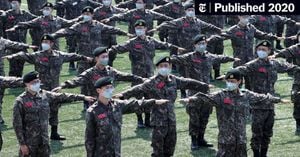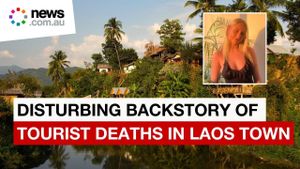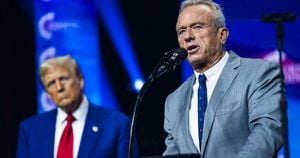Romania's political sphere is witnessing significant upheaval as the country prepares for its presidential runoff election on December 8. The unexpected emergence of Călin Georgescu, who identifies as a far-right independent candidate, shocked many when he emerged as the frontrunner with approximately 23% of the vote during the first round held on November 24. His campaign strategy, predominantly executed through the social media platform TikTok, has captivated voters, particularly younger ones.
Elena Lasconi, the center-right candidate from the progressive Save Romania Union (USR), follows closely behind Georgescu with about 19% of the votes. Lasconi aims to present herself as the reformist alternative, focusing on anti-corruption and aligning Romania more firmly with European Union policies. She is vying to become the first female president of Romania, which would mark a significant milestone for the nation's politics.
With the former Prime Minister Marcel Ciolacu of the Social Democratic Party (PSD) barely trailing Lasconi at about 19.15%, this election outcome marks the first time since Romania's post-communist era began 35 years ago without the PSD presenting a candidate for the presidency's second round. This shift not only indicates growing voter discontent with the traditional parties but also reflects broader global trends of seeking fresh leadership outside the established political framework.
Georgescu's candidacy may have emerged from relative obscurity, but his platform resonates with constituents who feel overlooked and marginalized. His statement post-voting emphasizes this sentiment, describing his support as one for "the unjust, for the humiliated... the vote is a prayer for the nation." This populist appeal aligns with the trends seen globally where candidates focusing on local grievances outperform expectations.
The election's turnout was reported at over 52%, with about 9.4 million of Romania's eligible voters participating. Interestingly, Georgescu gained 43.3% of the votes from the Romanian diaspora, which marks his support as notable compared to local voters where predictions had suggested he would struggle to secure even 10%.
Despite his rising popularity, Georgescu's lack of a clearly defined political agenda raises questions about how well his campaign can sustain itself against Lasconi's reform-oriented message. Lasconi's platform, prioritizing increased defense spending and supporting Ukraine amid the current geopolitical climate, positions her as the candidate of change, which is increasingly appealing to voters concerned with international relations and national security.
Currently, Romania faces upcoming parliamentary elections on December 1, potentially complicate the political environment for the presidential runoff. This dual electoral process could lead to shifting alliances and will be closely observed by both national and international analysts.
Both candidates' performances during the debate leading up to the runoff will be pivotal, with Lasconi needing to galvanize support to counterbalance Georgescu's grassroots momentum. Interestingly, the chief of the far-right Alliance for the Unity of Romanians (AUR), George Simion, captured around 13.87% of the votes, indicating the underscoring strength of nationalist sentiment within Romanian politics.
Georgescu, aged 62, promotes himself thoroughly through his social media channels, which appears to serve his campaign strategy well, especially as outreach on TikTok is increasingly relevant for younger demographics. With his academic background, including past roles at Romania's environment ministry and as a representative for the UN Environment Programme, he mixes experiences of governance with significant social media outreach, albeit without clear policy pathways disclosed to the electorate.
Georgescu's rise is particularly concerning for traditional parties accustomed to dominating Romanian politics, prompting many to re-evaluate their platforms and voter engagement strategies moving forward. Political analysts have cited his unexpected success as indicative of wider issues plaguing established parties across Europe.
Further complicate the political picture is Romania's pressing need for reform on multiple fronts, including judicial integrity, economic stability, and international partnerships, particularly amid broader European Union dynamics. The runoff, alongside the looming parliamentary elections, is poised to shape Romania's political realignment and its strategic direction within the EU and NATO.
Voter behavior patterns suggest increasing disillusionment with established political elites, particularly from the PSD. Observers are noting how key events, such as the Ukraine conflict and economic vulnerabilities, are influencing voter preferences and elevates candidates promising transformative change.
Against backdrop of rising populism worldwide, Romania's presidential race serves as both a reflection of domestic discontent and the shifting tides within Europe. The outcome not only affects Romania internally but also sends ripples through the European political fabric, particularly concerning how populist sentiments intertwine with pressures from external entities like the EU and geopolitical tensions.
Looking toward December's runoff, both candidates have separate challenges to navigate. Georgescu must convert his viral appeal on social media to substantial electoral support, potentially drawing on populist sentiments to rally undecided voters. Meanwhile, Lasconi aims to solidify her position as the face of reform and stability, focusing on corruption as the core issue confronting Romania.
The stakes couldn’t be higher for either candidate. Romania stands at the cusp of potential transformation, with voters increasingly seeking leaders who resonate with their experiences and amplify voices often drowned out by the political establishment. The narrative surrounding the elections leads to one overarching theme—how will Romania's electorate respond to its tumultuous political climate?



